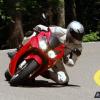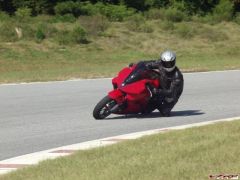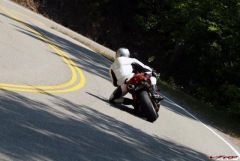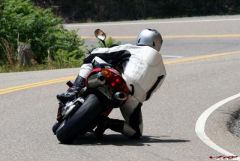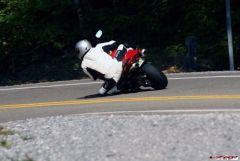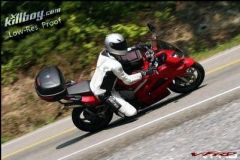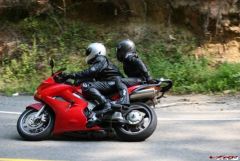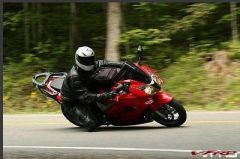-
Posts
1,012 -
Joined
-
Last visited
-
Days Won
1
Content Type
Forums
Profiles
Gallery
Blogs
Downloads
Events
Everything posted by jeremy556
-
Your profile shows an RC51 as gone. Did you do a RC51 on your VFR and are installing RC51 R&T forks? What calipers are you using? I had a '03 RC51 that was decked out. Ohlin's, Thorsten carbon fiber parts, PVM wheels, cams, head work, Sato's, etc. When my wife got cancer over a year ago. I wanted her to do some riding with me. So I put the RC back to stock as much as I could, sold it, and sold of the rest of the parts. Bought the VFR. Keep 1 set of Ohlins forks for the VFR, as I had 3 sets of them. When I was looking at the VFR, I was lurking here on the forum for information. :biggrin: That's where I got the :idea3: for the Ohlin forks. LOL As for the calipers. I'm sitting on a set of 108mm Brembo monoblock radial calipers right now. Problem I'm having is that nobody I talk to can give me the information I need for the disc off-set without machining thing some. I want to do this as a complete bolt-on. If I can't use the Brembo's, I use the RC51 calipers, as they are a great set-up to begin with. I just don't have a set right now. I hope your wife is doing well. As for the calipers, you may want to send a message to a member here, BusyLittleShop. IIRC, he had a similar issue with some R&T forks and Brembos for his RC45. He ended up machining his own out of magnesium or some foolishness, but I think he had found an off the shelf option as well.
-
Your profile shows an RC51 as gone. Did you do a RC51 on your VFR and are installing RC51 R&T forks? What calipers are you using?
-
The compression adjuster is the black knob on the end of the remote reservoir closest to the hose. The hose on the Ohlins is short, wish it were an inch or two longer.
-
Interesting. Why not go with an RC51 or F4i complete front end instead? Should have better suspenders, brakes, and wheel options either way. Why bother with an aluminum fuel cell on such a heavy bike? Wait, let me guess, you are a welder. :fing02: Nice beads.
-
Fuel cells are real. They chemically convert a fuel into electricity. The "water fuel cell" was one of the many scams. ETA Wikipedia info: Water Fuel Cell The water fuel cell is a device invented by American Stanley Meyer, which he claimed could convert water into its component elements, hydrogen and oxygen, using less energy than can be obtained by the subsequent combustion of those elements, a process that results the reconstitution of the water molecules. Thus, if the device operated as claimed, the combustion cycle would start and end in the same state while extracting usable energy, thereby violating both the first and second laws of thermodynamics, allowing operation as a perpetual motion machine. Meyer's claims about the Water Fuel Cell and the car that it powered were found to be fraudulent by an Ohio court in 1996.[1] Real Fuel Cells A fuel cell is an electrochemical conversion device. It produces electricity from fuel (on the anode side) and an oxidant (on the cathode side), which react in the presence of an electrolyte. The reactants flow into the cell, and the reaction products flow out of it, while the electrolyte remains within it. Fuel cells can operate virtually continuously as long as the necessary flows are maintained. Fuel cells are different from batteries in that they consume reactant, which must be replenished, whereas batteries store electrical energy chemically in a closed system. Additionally, while the electrodes within a battery react and change as a battery is charged or discharged, a fuel cell's electrodes are catalytic and relatively stable. Many combinations of fuel and oxidant are possible. A hydrogen cell uses hydrogen as fuel and oxygen as oxidant. Other fuels include hydrocarbons and alcohols. Other oxidants include air, chlorine and chlorine dioxide.[1]
-
The issue is, where does the hydrogen come from? If using electrolysis to get hydrogen from water, you are using the engine to power an alternator, which powers the electrolysis, to power the engine. :fing02:
-
This, and all of the “run on water” stories are BS. They are all scam artists trying to con people out of money. Separating Hydrogen from Oxygen takes more energy (in the form of electricity) than can be gained by burning the hydrogen.
-
The keys to not messing up the bike during transitions are to keep your butt off the seat (as Rice said), you should be sliding over the seat, not sitting on it, all your weight should be on your legs. The other thing is you may be supporting weight on your arms, if so, when you move your body you will inadvertently counter steer the bike. Another issue most people have when starting to hang off is they are crossed up, which eliminates the benefits of hanging off, while still adding the complexity. Make sure to concentrate on moving your upper body down and try to kiss your mirror. Keep your outside arm loose and rest it on the tank. Lean forward so your chest is near the tank. You can do this with your butt planted in the seat so you can work on one thing at a time. Like Bailey said, the upper body position will probably do more for you than hanging off.
-
Perhaps you had some other underlying problem that it would not drop from 225+ degrees? In routine 110 degree ambient temperatures mine would kick the fan on at 220 and would drop to 200 or at least stay between 210 and 220.
-
Start with setting your static sag. There is a How To in the How To section.
-
From the album: Jeremy556
-
From the album: Jeremy556
-
From the album: Jeremy556
-
From the album: Jeremy556
© ©vfdiscussion.com
-
From the album: Jeremy556
-
That the engine mount was behind the naca duct, would be my guess
-
You don't need to remove the throttle bodies to change the front tensioner. You can do it with a 1/4" ratchet, a couple extensions, a wobble, and a lot of cursing. :offtopic:
-
Touche
-
Why? That is one ugly mother f#$%er


